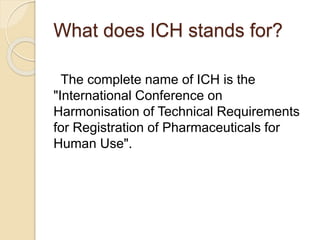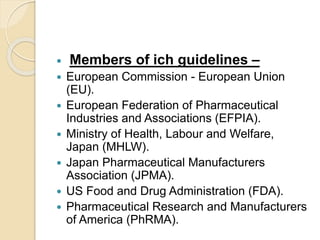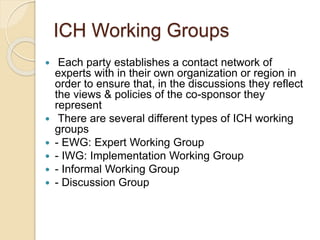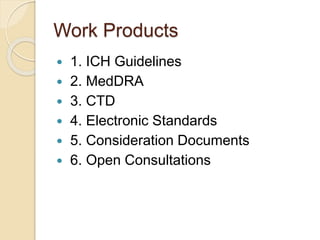Ich guideline
- 1. ICH(International Council on Harmonization) Guideline Presented by Aishwarya C. Patil. M.Pharm(first year) Pharmaceutics Rajarambapu College Of Pharmacy Kasegaon
- 2. What does ICH stands for? The complete name of ICH is the "International Conference on Harmonisation of Technical Requirements for Registration of Pharmaceuticals for Human Use".
- 3. Definition ? ICH is a joint initiative involving both regulators and research-based industry representatives of the EU, Japan and the US in scientific and technical discussions of the testing procedures required to assess and ensure the safety, quality and efficacy of medicines.
- 4. Objective - 1] More economical, use of humans, animal and for material resources. 2] Elimination of unnecessary delay in the global development and availability of -new medicines. 3] Maintaining safeguards on quality safety efficacy and regulatory obligation to protect public health.
- 5. ? Members of ich guidelines ©C ? European Commission - European Union (EU). ? European Federation of Pharmaceutical Industries and Associations (EFPIA). ? Ministry of Health, Labour and Welfare, Japan (MHLW). ? Japan Pharmaceutical Manufacturers Association (JPMA). ? US Food and Drug Administration (FDA). ? Pharmaceutical Research and Manufacturers of America (PhRMA).
- 6. History Need to harmonise? ? ©CIndustry becoming global ? ©C Duplicate test procedures ? Time consuming ? Expensive ? ©C Increasing R&D costs ? ©C Meeting public demand
- 7. History : Initiation of ICH ©C 1980s: European Community ©C 1989: WHO conference on Drug Regulatory Authorities, Paris ©C 1990: Birth of ICH, Brussels ? Europe ? Japan ? US ©C Topics for harmonisation divided into: Safety, Efficacy and Quality
- 9. Steering Committee ? Governing body that overseas the harmonization activities ? Six co-sponsors has two seats on the SC (EU, EFPIA, MHLW, JPMA, USFDA, PhRMA) ? 3 Observers are WHO, Health Canada, European Free Trade Association (EFTA) ? The IFPMA host the ICH secretarist & participartes as a non- voting member
- 10. GCG & MedDRA Management Board ? Global Cooperation Group represents from 5 Regional Harmonnizational Initatives (RHIĪ«s) APEC, ASEAN, EAC, GCC, PANDRH, SADC ? MedDRA mngt. Board:- Overall responsibility for direction of MedDRA. ? MedDRA an ICH stansardised dictonary of medical terminology ? The board oversees the activites of MedDRA Ī░Maintenance and Support ServicesĪ░ (MSSO) which serves as the repository, maintainer, developer and distributor of MedDRA.
- 11. Secretariat & Coordinators ? Secretariat located in Geneva, Switzerland, operating from IFPMA offices ? Secretariat staff is responsible for day to day management of ICH, namely preparations for & documentation of, meetings of the SC and its working group ? Coordinators: fundamental to the smooth running of ICH
- 12. ICH Working Groups ? Each party establishes a contact network of experts with in their own organization or region in order to ensure that, in the discussions they reflect the views & policies of the co-sponsor they represent ? There are several different types of ICH working groups ? - EWG: Expert Working Group ? - IWG: Implementation Working Group ? - Informal Working Group ? - Discussion Group
- 13. Process of Harmonization ? ICH harmonization activities fall into 4 categories ©C ? 1. Formal ICH Procedure: New topic for Harmonization ? 2. Q&A Procedure: Clarification on existing guideline ? 3. Revision Procedure ? 4. Maintenance Procedure
- 14. Work Products ? 1. ICH Guidelines ? 2. MedDRA ? 3. CTD ? 4. Electronic Standards ? 5. Consideration Documents ? 6. Open Consultations
- 15. QSEM GUIDELINES ? 1.Quality(Q) Guideline ? 2.Safety(S) Guideline ? 3.Efficacy(E)Guideline ? 4.Multidisciplinary(M)Guideline
- 17. ? 1. Quality Guidelines: ? Harmonization achievements in the Quality area include pivotal milestones such as the conduct of stability studies, defining relevant thresholds for impurities testing and a more flexible approach to pharmaceutical quality based on Good Manufacturing Practice (GMP) risk management
- 18. 2.Safety Guidelines: ICH has produced a comprehensive set of safety Guidelines to uncover potential risks like carcinogenicity, genotoxicity and reprotoxicity. A recent breakthrough has been a non-clinical testing strategy for assessing the QT interval prolongation liability: the single most important cause of drug withdrawals in recent years
- 19. ? 3.Efficacy Guidelines ? The work carried out by ICH under the Efficacy heading is concerned with the design, conduct, safety and reporting of clinical trials. It also covers novel types of medicines derived from biotechnological processes and the use of pharmacogenetics/genomics techniques to produce better targeted medicines
- 20. ? 4.MULTIDISCIPLINARY GUIDELINES: ? Those are the cross-cutting topics which do not fit uniquely into one of the Quality, Safety and Efficacy categories. It includes the ICH medical terminology (MedDRA), the Common Technical Document (CTD) and the development of Electronic Standards for the Transfer of Regulatory Information (ESTRI).REFERENCE- ICH Guidelines/ Work Products
- 22. ? Reference ©C ? 1.(Werner Nicklas International Harmonization of Health Monitoring ILAR Journal, Volume 49, Issue 3, 1 January 2008, Pages 338©C 346,https://doi.org/10.1093/ilar.49.3.338 ? 2.Mario Chen Family Health International Biostatistics Workshop NewDelhi, India, March2004 ? 3.https://en.wikipedia.org/.../International_C ouncil_for_Harmonisation_of_Technical_Re q...) ? 4.ICH Guidelines/ Work Products ?



![Objective -
1] More economical, use of humans,
animal and for material resources.
2] Elimination of unnecessary delay in
the global development and availability
of -new medicines.
3] Maintaining safeguards on quality
safety efficacy and regulatory obligation
to protect public health.](https://image.slidesharecdn.com/ichguideline-171120101024/85/Ich-guideline-4-320.jpg)


















